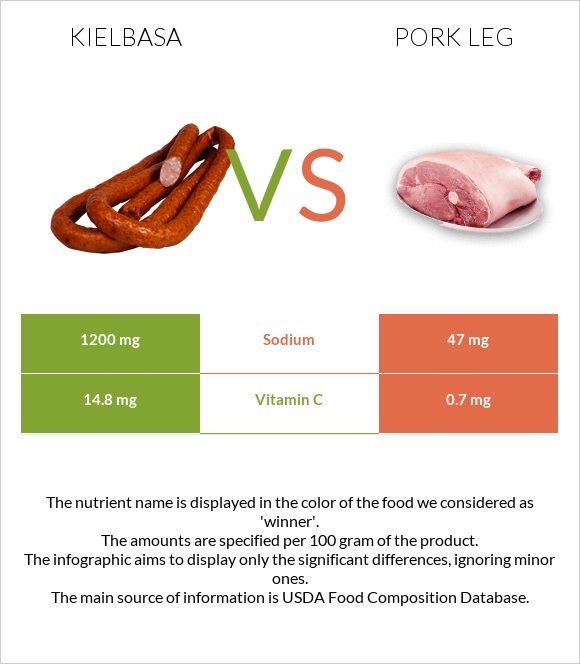Kielbasa vs. Pork leg — In-Depth Nutrition Comparison
Compare
Important differences between kielbasa and pork leg
- Pork leg has less vitamin C.
- Kielbasa's daily need coverage for sodium is 50% more.
- Kielbasa has 21 times more vitamin C than pork leg. Kielbasa has 14.8mg of vitamin C, while pork leg has 0.7mg.
- Pork leg is lower in sodium.
- Kielbasa has a higher glycemic index than pork leg.
The food varieties used in the comparison are Kielbasa, Polish, turkey, and beef, smoked and Pork, fresh, leg (ham), whole, separable lean, and fat, raw.
Infographic

Infographic link
Mineral Comparison
Mineral comparison score is based on the number of minerals by which one or the other food is richer. The "coverage" charts below show how much of the daily needs can be covered by 300 grams of the food.
| Contains more IronIron | +45.9% |
| Contains less SodiumSodium | -96.1% |
Vitamin Comparison
Vitamin comparison score is based on the number of vitamins by which one or the other food is richer. The "coverage" charts below show how much of the daily needs can be covered by 300 grams of the food.
| Contains more Vitamin CVitamin C | +2014.3% |
All nutrients comparison - raw data values
| Nutrient |  |
 |
DV% diff. |
| Vitamin B1 | 0.736mg | 61% | |
| Selenium | 29.4µg | 53% | |
| Sodium | 1200mg | 47mg | 50% |
| Vitamin B6 | 0.401mg | 31% | |
| Vitamin B3 | 4.574mg | 29% | |
| Phosphorus | 199mg | 28% | |
| Vitamin B12 | 0.63µg | 26% | |
| Zinc | 1.93mg | 18% | |
| Vitamin C | 14.8mg | 0.7mg | 16% |
| Vitamin B2 | 0.2mg | 15% | |
| Vitamin B5 | 0.685mg | 14% | |
| Protein | 13.1g | 17.43g | 9% |
| Potassium | 315mg | 9% | |
| Copper | 0.065mg | 7% | |
| Magnesium | 20mg | 5% | |
| Iron | 1.24mg | 0.85mg | 5% |
| Vitamin D | 20 IU | 3% | |
| Vitamin D | 0.5µg | 3% | |
| Fats | 17.6g | 18.87g | 2% |
| Folate | 7µg | 2% | |
| Polyunsaturated fat | 2.33g | 2.01g | 2% |
| Calories | 226kcal | 245kcal | 1% |
| Carbs | 3.9g | 0g | 1% |
| Cholesterol | 70mg | 73mg | 1% |
| Calcium | 5mg | 1% | |
| Manganese | 0.023mg | 1% | |
| Saturated fat | 6.23g | 6.54g | 1% |
| Net carbs | 3.9g | 0g | N/A |
| Monounsaturated fat | 8.27g | 8.38g | 0% |
| Tryptophan | 0.208mg | 0% | |
| Threonine | 0.776mg | 0% | |
| Isoleucine | 0.787mg | 0% | |
| Leucine | 1.376mg | 0% | |
| Lysine | 1.55mg | 0% | |
| Methionine | 0.444mg | 0% | |
| Phenylalanine | 0.689mg | 0% | |
| Valine | 0.931mg | 0% | |
| Histidine | 0.659mg | 0% |
Macronutrient Comparison
Macronutrient breakdown side-by-side comparison
| Contains more CarbsCarbs | +∞% |
| Contains more OtherOther | +176.4% |
| Contains more ProteinProtein | +33.1% |
~equal in
Fats
~18.87g
~equal in
Water
~62.47g
Fat Type Comparison
Fat type breakdown side-by-side comparison
| Contains more Poly. FatPolyunsaturated fat | +15.9% |
~equal in
Saturated fat
~6.54g
~equal in
Monounsaturated fat
~8.38g





